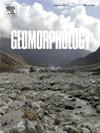微地形促进蚌岗侵蚀:崩塌壁面生态位的形成与稳定
IF 3.1
2区 地球科学
Q2 GEOGRAPHY, PHYSICAL
引用次数: 0
摘要
蚌岗侵蚀主要发生在南方花岗岩红壤地区,向侵蚀是其发展的主要动力。崩落壁上壁龛的发育标志着蚌岗朝前侵蚀的开始。生态位的形态演化和稳定机制研究相对较少。通过野外调查和典型案例研究,分析了自然生态位的形态特征和力学特性,以确定其主导控制因素。结果表明,生态位之间存在显著的形态差异。长轴、短轴与凹深呈极显著正相关(p <;0.01),共同影响其他参数。生态位以下切侵蚀为特征,主要呈椭圆形平面形态。以生态位发育为特征的塌壁剖面土壤性质表现出明显的空间异质性。抗剪强度的垂直非均质性是生态位发展的基础,与安全系数(FS)呈线性正相关。黏土含量的减少和水分的增加降低了生态位的稳定性,建立了生态位发展与土壤失稳之间的反馈机制。有机质、粘土含量和游离氧化铁是影响生态位稳定性的关键土壤性质,具有良好的预测能力(R2 = 0.876)。其中,有机质重要性得分最高(0.402),其次是粘土含量(0.312)和游离氧化铁(0.312)。形态参数是影响生态位稳定性的关键因素。随机森林和结构方程模型显示,长深比(LDR)对FS的贡献最大,其次是短深比(SDR)。这些发现为监测和模拟生态位的形态演变提供了重要的见解,增强了对崩塌壁的正向侵蚀的理解。本文章由计算机程序翻译,如有差异,请以英文原文为准。
Microtopography promoting Benggang erosion: Formation and stability of niche on collapsing wall
Benggang erosion occurs in granite red soil regions of southern China, where headward erosion acts as a key driver of its development. The development of niches on collapsing walls marks the initiation of Benggang headward erosion. The morphological evolution and stability mechanisms of niches remain relatively understudied. In this study, the morphological characteristics and mechanical properties of natural niches were analyzed based on field investigations and representative case studies to identify the dominant controlling factors. The results revealed that significant morphological variability among niches was observed. Moreover, the long axis, short axis and depth of concavity were highly significantly positively correlated (p < 0.01), collectively influencing the other parameters. Characterized by downcutting erosion, niches exhibited a primarily elliptical planar morphology. Soil properties within collapsing wall profiles characterized by niche development exhibited pronounced spatial heterogeneity. Vertical heterogeneity of shear strength was fundamental to niche development, demonstrating a positive linear relationship with the factor of safety (FS). A decrease in clay content and an increase in moisture reduced niche stability, establishing feedback mechanisms between niche development and soil destabilization. Organic matter, clay content and free iron oxide were critical soil properties influencing niche stability, with favorable predictive capacities (R2 = 0.876). Specifically, organic matter had the highest importance score (0.402), followed closely by clay content (0.312) and free iron oxide (0.312). Morphological parameters were key influencers of niche stability. Random forest and structural equation modeling revealed that the contribution of the length-depth ratio (LDR) was the highest for FS, followed by the short-depth ratio (SDR). These findings offered significant insights for monitoring and modeling the morphological evolution of niches, enhancing the understanding of the headward erosion of collapsing walls.
求助全文
通过发布文献求助,成功后即可免费获取论文全文。
去求助
来源期刊

Geomorphology
地学-地球科学综合
CiteScore
8.00
自引率
10.30%
发文量
309
审稿时长
3.4 months
期刊介绍:
Our journal''s scope includes geomorphic themes of: tectonics and regional structure; glacial processes and landforms; fluvial sequences, Quaternary environmental change and dating; fluvial processes and landforms; mass movement, slopes and periglacial processes; hillslopes and soil erosion; weathering, karst and soils; aeolian processes and landforms, coastal dunes and arid environments; coastal and marine processes, estuaries and lakes; modelling, theoretical and quantitative geomorphology; DEM, GIS and remote sensing methods and applications; hazards, applied and planetary geomorphology; and volcanics.
 求助内容:
求助内容: 应助结果提醒方式:
应助结果提醒方式:


